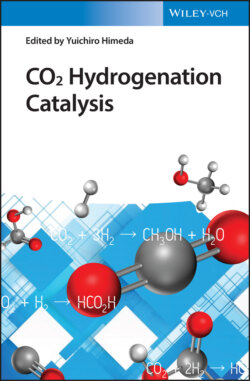Читать книгу CO2 Hydrogenation Catalysis - Группа авторов - Страница 10
1 Introduction
ОглавлениеYuichiro Himeda 1 and Matthias Beller 2
1National Institute of Advanced Industrial Science and Technology, Global Zero Emission Research Center, AIST Tsukuba West, 16‐1 Onogawa, Tsukuba, Ibaraki, 305‐8569, Japan
2Leibniz‐Institut für Katalyse, Applied Homogeneous Catalysis, Albert‐Einstein Straße 29a, 18059, Rostock, Germany
Of the final products of the combustion of carbon‐based fossil fuels, carbon dioxide (CO2) has the highest oxidation state and is known as the major cause of global warming. Annual CO2 emissions from anthropogenic activity in 2018 were approximately 33.1 Gton, an increase of 1.7% compared with 2017 [1]. Since the Industrial Revolution, two trillion tons of CO2 have accumulated in the atmosphere, and the current atmospheric concentration of CO2 has reached an unprecedented level of over 400 ppm (Figure 1.1) [2]. The anthropogenic emission of CO2 is associated with energy consumption, i.e. the combustion of carbon‐based fossil fuels, which currently account for around 85% of the world's energy.
According to the Paris Agreement of the United Nations, an overall limit on total cumulative CO2 emissions is crucial for our future development [3, 4]. According to the 2 °C scenario, further cumulative emissions should be limited to below one trillion ton of CO2. The spread of renewable energy (35%), advances in energy conservation (40%), and carbon capture and sequestration (CCS) technologies (14%) are sure to contribute to addressing the problem (Figure 1.2) [3]. However, it is clear that these methods will not completely solve the issues arising from the vast quantities of emitted CO2. In 2017, the International Energy Agency (IEA) presented the Energy Technology Perspectives (Beyond 2 °C Scenario: B2DS), which placed a much greater emphasis on the role of CO2 utilization for reducing emissions [3]. Indeed, in the next decade, we will still rely on carbon‐based products for fuels, polymers, commodity chemicals, cosmetics, detergents, and fabrics in modern life. If these chemicals were to be derived from CO2 instead of fossil oils, a sustainable carbon cycle will be possible.
